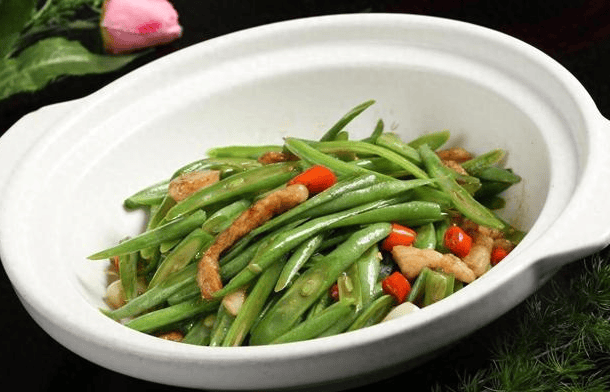Hypertension is a common health issue among middle-aged and elderly individuals, causing distress to many. Did you know that dietary adjustments can help control blood pressure? Today, we are going to uncover the miraculous blood pressure-lowering effect of a common ingredient – kidney beans. Kidney beans, not only a delicious home-cooked dish but also a “pressor inhibitor” for hypertension. Let’s delve deeper into kidney beans and several other foods that help maintain normal blood pressure, helping everyone improve their quality of life through healthy eating.
Blood Pressure-Lowering Effects of Kidney Beans
Nutritional Composition of Kidney Beans
Kidney beans are rich in various nutrients, including dietary fiber, protein, vitamin B, potassium, magnesium, and more. Dietary fiber helps lower cholesterol, improve gut health, while potassium and magnesium play crucial roles in blood pressure regulation. Studies show that increasing potassium intake in the diet can effectively reduce the risk of high blood pressure, while magnesium helps maintain normal vascular function and reduce vascular tension.
How Kidney Beans Help Lower Blood Pressure
Potassium is an important element in combating sodium, and individuals with high blood pressure usually need to reduce sodium intake and increase potassium intake. The abundance of potassium in kidney beans helps balance electrolytes in the body, reducing pressure on blood vessel walls to achieve the effect of lowering blood pressure. Additionally, dietary fiber in kidney beans promotes bowel movements, aiding in the elimination of excess sodium, further lowering blood pressure.
Optimal Ways to Consume Kidney Beans for Best Results
To fully utilize the blood pressure-lowering effects of kidney beans, it is recommended to diversify kidney bean consumption in daily diet by adding them to salads, soups, stews, etc. Consume kidney beans at least 3-4 times a week, pay attention to cooking methods, favoring steaming, boiling, and stewing while avoiding deep frying and excessive salt seasoning.
Other Blood Pressure-Lowering Foods
Dark Leafy Greens
Dark leafy greens like spinach, kale, Swiss chard are rich in potassium, magnesium, and dietary fiber. These nutrients help lower blood pressure. Potassium aids in flushing out excess sodium from the body, while magnesium promotes vascular relaxation. Research indicates that daily consumption of abundant dark leafy greens significantly reduces the risk of hypertension.
Fresh Fruits
Fruits such as bananas, oranges, avocados are rich in potassium and antioxidants, serving as effective tools against hypertension. Bananas, in particular, have a high potassium content, aiding in electrolyte balance adjustment within the body, reducing vascular tension. Oranges and avocados containing vitamins C and E help improve vascular elasticity and enhance cardiovascular health.
Nuts and Seeds
Nuts and seeds like almonds, walnuts, flaxseeds, chia seeds are rich in healthy fats, proteins, and magnesium, aiding in blood pressure reduction. Healthy fats help lower low-density lipoprotein (LDL) cholesterol, reducing the risk of cardiovascular diseases, while magnesium promotes vascular relaxation and blood pressure regulation.
Dairy Products
Low-fat or fat-free dairy products such as milk, yogurt, cheese are rich in calcium, potassium, and vitamin D, essential for maintaining healthy blood pressure levels. Calcium aids in vascular contraction and relaxation function, while potassium helps eliminate excess sodium from the body. Studies show that moderate intake of low-fat or fat-free dairy products significantly lowers the risk of hypertension.
Recommendations for Adjusting Daily Dietary Habits
Reduce Sodium Intake
Individuals with hypertension should minimize salt intake, keeping daily salt intake below 5 grams. Avoid high-salt processed foods like pickles, salted vegetables, kimchi, instant noodles, etc. During cooking, use natural spices and herbs instead of some salt to enhance food flavor.
Increase Dietary Fiber Intake
Dietary fiber helps lower cholesterol, improve gut health, and also assists in lowering blood pressure. Daily intake of 25-30 grams of dietary fiber is recommended, achievable by consuming more whole grains, vegetables, fruits, legumes, etc.
Weight Control
Overweight and obesity are significant risk factors for hypertension. Maintaining a healthy weight through balanced diet and moderate exercise significantly lowers blood pressure. Engaging in at least 30 minutes of moderate-intensity exercise daily, such as brisk walking, cycling, swimming, helps control weight and blood pressure.
Limit Alcohol Intake
Moderate alcohol consumption has certain health benefits, but excessive drinking leads to high blood pressure. Daily alcohol intake for men should not exceed 2 standard drinks and for women should not exceed 1 standard drink. It’s better to choose low-alcohol beverages like red wine and drink water moderately while consuming alcohol.
Case Studies of Healthy Eating
Case One: Mr. Zhang’s Blood Pressure Journey
Mr. Zhang, 65 years old, had consistently high blood pressure after retiring, and the doctor advised him to adjust his diet. Mr. Zhang started reducing salt intake, eating a banana daily for potassium, and adding kidney beans and dark leafy greens to his lunch and dinner. Three months later, Mr. Zhang’s blood pressure decreased from 150/95 mmHg to 130/85 mmHg. He mentioned that through healthy dietary adjustments, not only was his blood pressure under control, but he also felt more relaxed.
Case Two: Aunt Li’s Healthy Dining Table
Aunt Li, 70 years old, had hypertension for many years and usually took antihypertensive medications. Following the doctor’s advice, she started eating a small handful of nuts daily, drinking a cup of low-fat milk for breakfast, and adding various fruits and vegetables to her lunch and dinner. Six months later, Aunt Li’s blood pressure decreased from 160/100 mmHg to 140/90 mmHg, and she noticed a significant improvement in her mental state.
By scientifically adjusting the diet, hypertension can be effectively controlled and reduced. Foods like kidney beans, dark leafy greens, fresh fruits, nuts and seeds, low-fat dairy products contribute to maintaining normal blood pressure. The key is to adhere to healthy dietary habits, reduce sodium intake, increase dietary fiber, maintain a healthy weight, limit alcohol consumption. It is hoped that everyone can manage blood pressure within a normal range through rational dietary and lifestyle management, and possess a healthy body.


